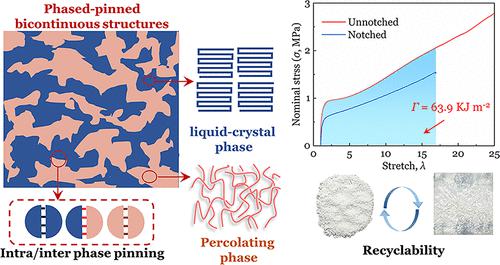当前位置:
X-MOL 学术
›
Macromolecules
›
论文详情
Our official English website, www.x-mol.net, welcomes your
feedback! (Note: you will need to create a separate account there.)
Phase-Pinned Bicontinuous Structures Reconciling with the Superior Fracture Toughness and Reusability of Ionic Elastomers
Macromolecules ( IF 5.1 ) Pub Date : 2023-12-12 , DOI: 10.1021/acs.macromol.3c01656 Zibi Wang 1 , Xiaoxu Liu 1 , Fahu Yang 1 , Xinxin Li 1 , Haipeng Li 1 , Dong Liu 1 , Fei Chen 1
Macromolecules ( IF 5.1 ) Pub Date : 2023-12-12 , DOI: 10.1021/acs.macromol.3c01656 Zibi Wang 1 , Xiaoxu Liu 1 , Fahu Yang 1 , Xinxin Li 1 , Haipeng Li 1 , Dong Liu 1 , Fei Chen 1
Affiliation

|
Imperative integrations of high fracture toughness and reusability are seemingly contradictory in ionic elastomers due to their intrinsically opposite network designs. Such combinations, however, are paramount for soft electronics, tissue engineering scaffolds, and ionic skins with a long service life. Here, we engineer a supramolecular ionic elastomer with phase-pinned bicontinuous structures to reconcile these incompatible properties through elaborately regulating the association dynamics and chain entanglement. The continuous liquid-crystal phase with sticky fluorine-chain association provides a high fracture energy barrier and effective energy dissipation, while the continuous percolating phase with flexible chain entanglement enables good stretchability and elasticity. Moreover, these bicontinuous phases are pinned by dynamic intra/interphase noncovalent interactions, facilitating the load distribution and network reconfiguration. Therefore, the crack growth under single and cyclic loads is suppressed, fulfilling the brilliant toughness (60.3 MJ m–3), fracture energy (63.9 KJ m–2), fatigue threshold (1.56 KJ m–2), and ultrastretchability (∼3040%) requirements, while achieving excellent recyclability and self-healability through reversible network reconstruction.
中文翻译:

相钉双连续结构与离子弹性体的优异断裂韧性和可重复使用性相协调
由于其本质上相反的网络设计,离子弹性体中高断裂韧性和可重复使用性的必要整合似乎是矛盾的。然而,这种组合对于软电子、组织工程支架和使用寿命长的离子皮肤至关重要。在这里,我们设计了一种具有相固定双连续结构的超分子离子弹性体,通过精心调节缔合动力学和链缠结来协调这些不相容的特性。具有粘性氟链缔合的连续液晶相提供了高断裂能垒和有效的能量耗散,而具有柔性链缠结的连续渗滤相具有良好的拉伸性和弹性。此外,这些双连续相由动态的相内/相间非共价相互作用固定,促进负载分配和网络重新配置。因此,单次和循环载荷下的裂纹扩展得到抑制,满足优异的韧性(60.3 MJ m –3)、断裂能(63.9 KJ m –2)、疲劳阈值(1.56 KJ m –2)和超拉伸性(∼3040 %)要求,同时通过可逆网络重构实现优异的可回收性和自修复性。
更新日期:2023-12-12
中文翻译:

相钉双连续结构与离子弹性体的优异断裂韧性和可重复使用性相协调
由于其本质上相反的网络设计,离子弹性体中高断裂韧性和可重复使用性的必要整合似乎是矛盾的。然而,这种组合对于软电子、组织工程支架和使用寿命长的离子皮肤至关重要。在这里,我们设计了一种具有相固定双连续结构的超分子离子弹性体,通过精心调节缔合动力学和链缠结来协调这些不相容的特性。具有粘性氟链缔合的连续液晶相提供了高断裂能垒和有效的能量耗散,而具有柔性链缠结的连续渗滤相具有良好的拉伸性和弹性。此外,这些双连续相由动态的相内/相间非共价相互作用固定,促进负载分配和网络重新配置。因此,单次和循环载荷下的裂纹扩展得到抑制,满足优异的韧性(60.3 MJ m –3)、断裂能(63.9 KJ m –2)、疲劳阈值(1.56 KJ m –2)和超拉伸性(∼3040 %)要求,同时通过可逆网络重构实现优异的可回收性和自修复性。































 京公网安备 11010802027423号
京公网安备 11010802027423号